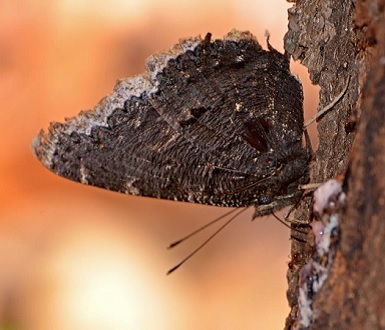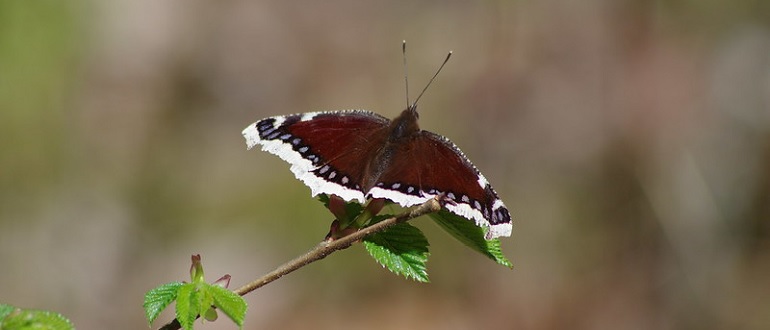A True Survivor
GET TO KNOW Mourning Cloaks
If butterflies played Survivor, the mourning cloak would surely win.
FUN FACT: Caterpillars grow through stages (known as instars) by shedding their skin an average of 5 times. Some caterpillars even change color as they move through these stages. Mourning cloaks start off plain black but develop spines and red spots as they move into different instars.
With a tool kit of survival techniques, a far-reaching native range, and a long life span, the mourning cloak is a champion.
As winter approaches, creatures of the wild rely on various survival strategies. Most butterflies either migrate or hibernate in chrysalis form for winter. However, the mourning cloak toughs it out as an adult butterfly. This little guy hunkers down in a cozy crack in the tree bark and freezes – actually freezes – as temperatures fall. Mourning cloaks are one of the few insects species believed to be freeze tolerant. At the upper edge of their range (northern Manitoba, Canada), adult mourning cloaks have been found to survive extreme cold temperatures around -60 ⁰C (= -76⁰F). To be freeze tolerant, an organism must be able to control, and survive, the formation of ice crystals within its living cells. This is accomplished by internally flooding cells with certain proteins and sugars to control ice formation. To read more on freeze tolerance vs freeze avoidance mechanisms, see this Iowa State University article.
Come spring, after waking up from a long winter’s nap, mourning cloaks are often the first butterflies to be seen. Once temperatures reach 50⁰ F, they able to sun themselves on a warm rock and absorb enough warmth to take flight. They may wake in early April and are sometimes seen flying above a late snow. Conversely, if the summer weather gets too hot and dry, adult mourning cloaks may also spend some time in a summer “sleep” known as aestivation whereby they find a nice, shady spot to go dormant and rest.
Mourning cloaks, with velvety wings opened wide, are true beauties. However, with wings closed, they are a rough looking gray in imitation of tree bark. This coloring provides camouflage for the tree loving butterfly while it is feeding, hibernating or playing dead.

Yes, much like opossums, mourning cloaks feign death when frightened. They close their wings, tuck up their legs, tip over, and remain motionless until they think the danger has passed.
For butterflies, the dangers are many. Most especially there are all those birds that want a tasty butterfly snack. But, with so many survival strategies, it is no surprise that mourning cloaks are believed to be the longest-lived butterfly species. These beauties often enjoy an adult life span of 11 to 12 months. Yet dodging predators and surviving the seasons takes a toll; and older mourning cloaks are often faded, tattered, and torn. Nonetheless, these tough little butterflies flutter on and bring us joy.
HABITAT & LIFE CYCLE
With a native range that encompasses most of North America, most of Europe, and much of Asia, mourning cloaks probably have the largest natural range of all butterflies.
Unlike most butterflies, mourning cloaks are not fans of pretty flowers. Instead, as both adults and caterpillars, these guys prefer trees. Adults feed on tree sap, rotting fruit, and even mud or dung to extract minerals. Caterpillars feed on the leaves of trees. Favorite trees include wetland species such as willows, poplars, and birch. However, since mourning cloaks are not particularly fussy, caterpillars may also feed on elms, aspen and hackberries. This wide flexibility of acceptable caterpillar host plants is another example of this butterfly’s many survival strategies.
Male mourning cloaks are territorial and are known to perch high in trees to watch for intruders. Naturally, male intruders are chased away. But visiting lady mourning cloaks are happily welcomed. After mating in the spring, female mourning cloaks lay their eggs (in clusters of up to 50 eggs) on a stem or leaf of a favorite tree. As the eggs hatch, the tiny black caterpillars stay close together, in a protective unit, to feed on the leaves. If they sense danger, the whole group may pull together and twitch in unison in an effort to make a threatening display. (Not really sure how threatening that is – but hey, they try!) Additionally, if they run out of leaves to chew in one spot, the caterpillar family crawls off en masse in search of fresh leaves. Eventually though, after several weeks of feeding together, the caterpillars strike out individually to find safe places to morph into their chrysalises. And several weeks after that, they emerge in the summer as beautiful mourning cloak butterflies.
TAKE ACTION
Even though these superstar survivors are considered plentiful across their range, they are still at risk from insecticides and habitat loss. It is very important to maintain natural areas of wooded wetlands for mourning cloaks and other animals.
You can help by learning about native trees and supporting the planting of appropriate native species. Additionally, help spread the word to reduce the use of insecticides and chemical yard sprays. Please see our page on watershed protection at home at PROTECTING THE ROUGE Get involved to help Friends of the Rouge protect our watershed and wetland trees today.
MAIN PHOTO CREDIT: Caption: Mourning Cloak Butterfly (Nymphalis antiopa) by Aah Yeah -CC-BY-2.0 – IMAGE CROPPED
